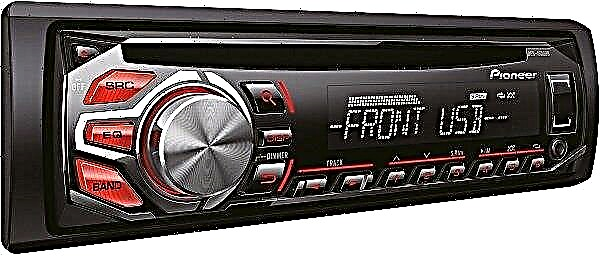

The content of the article:
- Wheels and tires
- Engine
- Battery
- Body
- Technical fluids
- Additional Tips
- What you need in a car in winter
"And what, it generally needs to be cooked somehow?" - some readers will ask. Yes, you have to. The only question is what exactly your car needs. Modern technology requires less personal care than, for example, the Russian car industry of previous years. But, in any case, there are preparation points from which you cannot "leave" even on a brand new, coolest SUV. If you neglect them, winter driving will seem like one big problem to you.
Understanding the basics of preparation will be useful even for those who hide their "swallows" in the cold weather in garages. Especially if the room is not heated and there is a possibility of freezing of technical fluids of the vehicle.
Wheels and tires for winter

Riding on the snow on the same tires as in summer is the same as walking on snowdrifts with flippers - interesting, but inconvenient. Obviously not everyone will like it. And it will definitely not add security. Let's take a look at everything related to car shoes:
- First of all, we drop the steepness and buy stamped rims. Casting looks beautiful, but it carries dirt and snow on itself in winter. Then this mixture hardens and gives such an imbalance on each side that when driving there will be a feeling of "square wheels". This is not an easy test for the suspension of a car.
- Choosing rubber. Immediately discard the option of all-season tires, of course, unless you live in a warm climate. In the weather conditions of our winters, they are useless. There are two types of tires left: studded and Velcro. When choosing, you need to clearly understand where you are going to drive. Non-studded rubber will do its job only in a well-cleaned city. Since such conditions are more likely dreams than reality, it is better to take a studded one. These tires will "bite" into both drifts and ice, and give you the best flotation.
- If there are winter wheels from last season, then before putting them on the car, inspect their appearance. Check the number of spikes, the condition of the cord and discs, for dents, bumps and cuts. Balancing is desirable.
- Do not delay changing the rubber. Most of the drivers turn to the tire service only with a “kick” of snowfall. Here you have two problems at once: lack of safety on the way to the place of changing shoes and kilometer-long queues of the same short-sighted sufferers. At a constant temperature below +10 degrees, you can already think about replacing tires and sign up for a tire fitting queue.
- Often, trying to save money, motorists put winter tires only on the drive axle of the car. Remember and never do this! In this case, you will lose control of the car and will not be able to control it even with the slightest maneuvers. For example, if you install good rubber on the front axle, when cornering, the sliding rear of the car will "overtake" the face and spin the car in place. Quite a dangerous "dance" in the city.
- After installation, check the tire pressure - it should be slightly higher than in summer.
- According to the latest change in the law, it is imperative to stick the badge with the letter "Ш" on the rear window, if the car has studded wheels.
- To keep summer rubber in shape, you need to know how to store it properly. If you have it on disks, then lay it horizontally (on its side) or leave it hanging. If only the tires themselves are available, they can be stored exclusively in a standing (upright) position.
Car engine in winter

If the car is regularly serviced, and the latter was not so long ago, then the following most likely will not be useful to you. But just in case, it is worth checking the entries in the service book, namely the marking of the filled engine oil:
- In frosts, the oil thickens and not any of its types is able to ensure the operation of the engine. A product not adapted for winter can damage the car. If you don't know exactly what kind of oil is in your car, you should play it safe and fill in a new one. More often recently, synthetics of medium viscosity have been used. Consider carefully the choice of the product - it is best to use the brands recommended by the automakers.
- The fresher the engine oil is, the less it thickens and the better it does the job.
- Do not forget about the oil filters - they must also be replaced.
- Semi-dead candles can cope with their task in summer, but in winter their performance decreases sharply. Have you tried at least once to twist them in a thirty-degree frost on the street? That is also a "pleasure". Therefore, take care of this in advance and make a replacement in comfort and warmth.
Preparing the battery for winter

Here it is, the Achilles heel of any frozen car. There is no problem in winter more frequent and commonplace than a dead battery. This situation cannot be completely prevented, since in cold weather the battery works at its peak. But it's worth trying to reduce the likelihood of trouble:
- Don't wait for the battery to "die" by its own death. Its average service life is about 3-4 years. Change the battery before winter;
- A dead battery can be revived with a charger, cigarette lighter wires or a hot water bath at home (the body is submerged by a third);
- There are two types of accumulator: serviceable and unattended. In the first case, you can open it, check the electrolyte level, measure the density and voltage. In the second, just clean the terminals and find out the voltage;
- In winter, drivers are often mistaken that the car must be started several times a day if the temperature drops below 20 degrees. The battery hardly charges when the vehicle is stationary! But a lot of energy is spent on turning the frozen units. Frequent planting without further driving consumes the battery, and the next time the charge to start the engine may not be enough.
Car body in winter

Modern cars are prepared for the difficult "life" in the winter. They all undergo special treatment against the destructive effects of temperature, dirt and reagents that are watered on the streets. But the owner of an old VAZ, for example, should take care of the safety of body parts and cover them with a protective compound. Otherwise, cracks and rust will manifest themselves very quickly.
Further tips apply to all vehicles:
- Rubber seals tan in the cold, freeze, and sometimes crumble. Often, through their fault, it becomes impossible to open a door or window. A simple silicone lubrication procedure will eliminate these problems.
- Locks also tend to freeze in winter, especially if water gets there before washing the car. Therefore, do not spare grease for them. If, nevertheless, trouble happens, and the car does not want to let you into the cabin, heat the key with a lighter and insert it into the lock, if necessary, repeat it several times. This will heat the well and the key will turn.
- Do not be indifferent to the wipers. They work out most of the service just in the autumn-winter period. If you are going to buy new ones, then buy a better special winter version. They are more elastic and less prone to snow adhesion.
Technical fluids under the hood in frost

What exactly should not be forgotten when cold weather comes is about replacing the water in the car with an anti-freeze liquid:
- Freezing of the cooling system poses a serious danger to the engine. Therefore, you must be absolutely sure that antifreeze is poured inside, and not water.Recently, antifreeze began to be used year-round, regardless of the temperature characteristics of the region. Be sure to check, especially if you bought a car not so long ago, whether there is definitely antifreeze inside. At the slightest doubt, replace the fluid with the recommended one.
- The hardening of the washing agent can also bring big troubles. In the summer we all use water to wash our windows, that's understandable. Only in the fall, many motorists forget to change it to an anti-freeze. This leads to complete solidification of the tank and washer pipes.
It will take a long time to warm up. To do this, you can use a warm box or an underground supermarket parking lot. To prevent such a situation, change the liquid in time, before the first frost. When choosing a product, pay attention that there is no strong unpleasant odor, otherwise its use may result in nausea, dizziness, and in some cases, serious poisoning. Ordinary, the cheapest vodka can be a good alternative to washer fluid.
Additional preparation tips

There are some other useful notes for winter driving comfort:
- Since daylight hours are limited, and darkness takes most of the day, carefully monitor the health of the headlights and dimensions;
- Examine interior heaters, windows and mirrors to see if everything is working;
- Take the brake system check seriously. Uneven clamping of the pads on a slippery road can lead to skidding;
- The same is with the hand brake - it often freezes in the depressed position and blocks the wheels;
- Do not defrost the car locks with hot water. Yes, it is an effective remedy, but what are the consequences? Firstly, the paintwork suffers from a sharp temperature drop. And, secondly, the water ends up in the well. It is now hot and does not allow the lock to freeze, but after a few minutes it will cool down and will only complicate further opening. It is better to use a heated key or a special well-known means;
- Cleaning glasses with hot water is also dangerous. An abrupt transition from cold to warmth can destroy not only ice, but also the glass itself;
- You need to wash your car more often in winter. Salt, dirt and reagents destroy the bodywork. But this must be done with cool water so that there is no sharp difference in temperature.
What you need in a car in winter

For those who often travel outside the city, this item will be especially relevant. But, given the snowiness of the last winters, it will come in handy in "civilization":
- A long-handled brush and a glass scraper will remove snow and ice from the car;
- The shovel will help you get out of the snowdrift;
- Lighting wires will revive someone's battery;
- Rugs with high sides will prevent snow from entering and melting under the interior trim, which, in turn, will not cause rust and decay there;
- The crankcase protection will ensure the safety of parts and assemblies from a high icy track;
- Alarm with auto start will noticeably "warm" the life of the driver;
- On long trips, take a phone charger, cable, warm clothes or a blanket with you and write down the tow truck number.
Preparing a car for cold weather is a responsible process. In some cases, incorrect actions can lead to serious damage or accidents. But equally important is the driver's ability to quickly adapt to weather conditions. Changing the driving style in time will allow you to avoid troubles and not make mistakes on the road.











